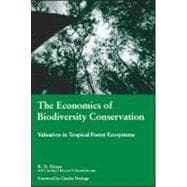
Note: Supplemental materials are not guaranteed with Rental or Used book purchases.
Purchase Benefits
What is included with this book?
| List of Figures, Tables and Box | p. viii |
| Foreword | p. xvii |
| Preface | p. xix |
| List of Acronyms and Abbreviations | p. xxiii |
| Introduction | p. 1 |
| Biodiversity conservation: Its significance and the issues | p. 1 |
| Tropical forests | p. 3 |
| Factors causing biodiversity loss | p. 5 |
| The economic case for valuing biodiversity | p. 6 |
| Total economic value of tropical forests | p. 8 |
| The Western Ghats biodiversity hotspot | p. 10 |
| Survey of literature and justification for the study | p. 17 |
| Objectives | p. 36 |
| Data and approach | p. 36 |
| Structure of the book | p. 44 |
| Land Use and Crop Pattern Changes, Pressure on Natural Resources and the Status of Biodiversity in Selected Regions | p. 45 |
| Introduction | p. 45 |
| Land use patterns and changes | p. 45 |
| Crop patterns and changes | p. 52 |
| Population pressure on natural resources | p. 56 |
| Livestock pressure on natural resources | p. 58 |
| Status of biodiversity in the Western Ghats biodiversity hotspot | p. 61 |
| Summary | p. 73 |
| Note | p. 75 |
| Maldari - The Context of a Coffee Growing Village | p. 76 |
| Introduction | p. 76 |
| Maldari village | p. 76 |
| Profile of the sample households | p. 77 |
| Coffee cultivation in Maldari | p. 82 |
| The opportunity cost of biodiversity conservation | p. 89 |
| External costs | p. 94 |
| The local community's perceptions and attitudes towards the environment and biodiversity conservation | p. 98 |
| Valuing the local community's preferences for biodiversity conservation | p. 104 |
| Summary | p. 109 |
| Nagarhole - The Context of Tribal Villages Located Within and Near a National Park | p. 110 |
| Introduction | p. 110 |
| Nagarhole National Park | p. 111 |
| Tourist arrivals and revenues | p. 116 |
| Income and expenditure of park | p. 117 |
| Sample selection | p. 118 |
| Profile of the sample households | p. 120 |
| Wildlife damage costs | p. 123 |
| Tribal communities' dependence on forests for non-timber forest products | p. 126 |
| Local tribal communities' perception and attitudes towards the environment and biodiversity conservation | p. 158 |
| Valuing local tribal communities' preferences for biodiversity conservation | p. 163 |
| Summary | p. 166 |
| Uttar Kannada: The Context of Agricultural cum Pastoral Villages Located Within and Near a Wildlife Sanctuary | p. 167 |
| Introduction | p. 167 |
| Uttar kannada district | p. 167 |
| Dandeli wildlife sanctuary | p. 168 |
| Sample selection | p. 169 |
| Profile of the sample households | p. 170 |
| The opportunity costs of biodiversity conservation | p. 178 |
| Forest resources and household income | p. 196 |
| Wildlife damage costs and defensive expenditure | p. 197 |
| The local community's perception and attitudes towards the environment and biodiversity conservation | p. 200 |
| Valuing the local community's preferences for biodiversity conservation | p. 204 |
| Summary | p. 207 |
| Summary, Conclusions and Policy Recommendations | p. 209 |
| Introduction | p. 209 |
| Major findings | p. 211 |
| Policy implications | p. 219 |
| Glossary | p. 228 |
| References | p. 241 |
| Index | p. 250 |
| Table of Contents provided by Ingram. All Rights Reserved. |
The New copy of this book will include any supplemental materials advertised. Please check the title of the book to determine if it should include any access cards, study guides, lab manuals, CDs, etc.
The Used, Rental and eBook copies of this book are not guaranteed to include any supplemental materials. Typically, only the book itself is included. This is true even if the title states it includes any access cards, study guides, lab manuals, CDs, etc.